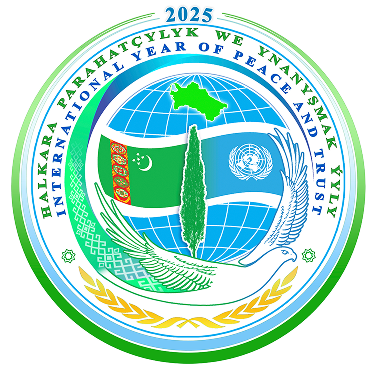TURKMENISTAN
GENERAL INFORMATION
On October 27, 1991, Turkmenistan became an independent State, and since then this date has been marked as the Independence Day. On December 12, 1995, Turkmenistan was recognized as a permanently neutral State by the resolution of the UN General Assembly with the unanimous support of 185 member States. At present Turkmenistan has established diplomatic relations with 142 countries.
Turkmenistan is a democratic, law-based, secular State. The form of government is a Presidential republic. The political structure of the Turkmen state is formed in accordance with the Constitution of Turkmenistan, adopted on May 18, 1992 (the revised on September 14, 2016). The Сonstitution of Turkmenistan is the basic law of the State. According to that law, Turkmenistan’s state structure is based on the principle of separation of powers into legislative, executive and judicial branches which act independently and balance each other. Constitutionally fixed norms and provisions are directly applicable. Laws and other legal acts that contradict the Constitution have no legal force.
The people of Turkmenistan is the bearer of sovereignty and the sole source of State power.
The State guarantees the freedom of religions and confessions and their equality before the law. Religious organizations are separate from the State and may not interfere in State affairs or fulfil state functions. The public education system is separate from religious organizations and is secular.
The President of Turkmenistan is the highest official of Turkmenistan. He is the Head of the State and executive power. The President of Turkmenistan chairs the Cabinet of Ministers – the Government of Turkmenistan. The President of Turkmenistan is the guarantor of the country’s independence and neutral status of Turkmenistan, its territorial integrity; of respect for the Constitution; and of fulfilment of international obligations. The President of Turkmenistan is the Supreme Commander of the Armed Forces of Turkmenistan.
Legislative power is exercised by the supreme representative body – the Mejlis (Parliament) of Turkmenistan, which consists of 125 deputies, elected in accordance with the territorial election districts for a term of 5 years. The elections of the deputies of the Mejlis are carried out by the citizens of Turkmenistan on the basis of nationwide, equal and direct electoral law by secret ballot on alternative platforms.
Judicial power in Turkmenistan resides solely in the courts. The judicial branch is meant to safeguard the rights and freedoms of citizens and the legally protected interests of the State and society.
The territory
The territory of Turkmenistan covers 491, 21 thousand sq km. Its territory stretches for 1100 km from west to east and extends for 650 km from north to south. In the north Turkmenistan borders with the Republic of Kazakhstan, in the north-east and in the east Turkmenistan shares borders with the Republic of Uzbekistan, in the south-east Turkmenistan borders with the Islamic Republic of Afghanistan, and in the south – with the Islamic Republic of Iran. In the west the country’s natural boundary is the Caspian Sea, through which Turkmenistan borders with the Republic of Azerbaijan.
Population
The population of Turkmenistan is more than 6.2 million people. Turkmenistan is a multinational state. There are more than 100 nations and ethnic groups living in the country.
State language
The Turkmen language is the state language. The use of their native language is guaranteed to all citizens of Turkmenistan. The educational institutions of Turkmenistan ensure learning of three languages – Turkmen, English and Russian. In addition, the higher educational institutions and some specialized secondary schools include study of French, Chinese, German, Japanese and some other foreign languages.
Currency
The national currency is manat, put into circulation on November 1, 1993. Currently, the ratio of the national currency to a freely convertible currency is: 3,50 manats = 1 US dollar.
The Government Programme of Development the Banking System for 2011-2030 was adopted and has been successfully implemented. In addition, in Turkmenistan over the past few years, the country’s financial institutions have carried out an extensive work to develop the securities market. Currently, the population of the country is provided with maintenance services of bank cards "Visa", "Visa Electron", "Visa Classic", "Visa Gold", and legal persons–"Visa Business" cards. The banks continue to work on the introduction of international payment cards, in particular, the system of "Master Card" in order to establish non-cash payments in the field of trade.
Administrative and territorial structure
The capital city of Turkmenistan is Ashgabat, which is an administrative and territorial unit with province-wide powers (velayat). Ashgabat consists of 6 districts (etraps): Bagtyyarlyk district, Berkararlyk district, Kopetdag district, Archabil district, Abadan district and Rukhabat district.
Turkmenistan is divided into 5 provinces – Ahal, Balkan, Dashoguz, Lebap and Mary. Each province is divided into districts. There are 50 districts, 24 towns, including 15 towns district-wide, 76 villages and 553 rural councils (rural municipal units) and 1903 rural settlements in Turkmenistan.
State holidays and remarkable dates of Turkmenistan
The major state and national holidays of the State:
New Year – January 1;
Day of the State Flag of Turkmenistan – February 19;
International Women’s Day – March 8;
National Spring Holiday – March 21-22;
Victory Day – May 9;
the Day of the Constitution and the Day of Revival, Unity and Poetry of Magtymguly – May 18;
Turkmenistan’s Independence Day - October 27-28;
The International Day of Neutrality – December 12.
Specific dates of annually marked holidays Eid al-Adha and Eid al-Fitr are determined in accordance with the decrees of the President of Turkmenistan.
Memorial days:
National Commemoration Day – October 6.


 TURKMENISTAN
TURKMENISTAN